The Skull and Crossbones Nebula is a large star forming region located approximately 20,000 light-years away in the southern constellation of Puppis. It has an apparent magnitude of 7.1 and appears near the star Azmidi (Xi Puppis). The nebula has the designation NGC 2467 in the New General Catalogue.
Much like the brighter Orion Nebula (Messier 42), the Skull and Crossbones Nebula is composed of vast clouds of gas and dust where hot, young, blue stars are forming. The large clouds of predominantly hydrogen gas serve as a very active stellar nursery. Some of the new stars born within the nebula are still shrouded in their birth cocoons of gas while others have eroded the clouds away and can be spotted in visible light. The embedded stars shine brightly in the ultraviolet.
The Skull and Crossbones Nebula was discovered by the German-born English astronomer William Herschel on December 9, 1784. The colorful star-forming region was named Skull and Crossbones because of its unusual appearance and oddly shaped dust clouds. The resemblance to a skull is particularly strong in an image released by the European Southern Observatory (ESO) in December 2005.
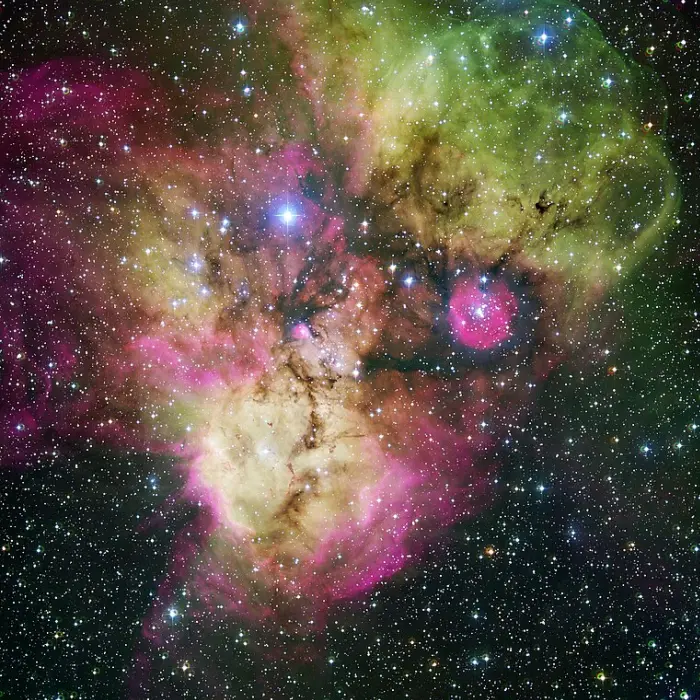
Skull and Crossbones Nebula (NGC 2467), image: ESO (CC BY 4.0)
The nebula’s appearance has also been compared to that of a mandrill. The dark dust clouds around the “eyes” are silhouetted against the emission nebulosity that lies in the background.
The Skull and Crossbones Nebula is not associated with a single open cluster. The designation NGC 2467 once applied to what was thought to be the central cluster of the Puppis I association. However, the stars that appear in the region of the nebula belong to several different groups that appear in the same line of sight. These stellar groups lie at different distances and have different radial velocities.
The star forming complex contains many Herbig-Haro objects, pillars of gas, and Bok globules. It is home to two young open star clusters, catalogued as Haffner 18 (H18) and Haffner 19 (H19). The nebula also contains a structure, S311, which is excited by the hot, blue O6V-type star HD 64315. S311 appears spherical and is almost fully surrounded by a dust ring. The structure has an estimated age of 1 to 4 million years.
The distances to the open clusters Haffner 18 and Haffner 19 are uncertain. Astronomers have estimated that H19 and the S311 nebula are approximately 21,000 light-years (6.4 kiloparsecs) away and that H18 is 19,000 light-years (5.9 kiloparsecs) away.
The cluster H18 contains several hot, blue OB stars, and the whole region appears to contain numerous stars, many of them high mass, that may or may not be associated with the nebulosity. H18 is home to a very young star, FM3060a, that is still embedded in its birth cloud.
H19 is a compact young cluster that contains a Strömgren sphere, a dense shell of hydrogen that surrounds a massive young star of the spectral type B0 V. The cluster has an estimated age of 2 million years.
The cluster H19 marks the right eye of the Skull Nebula and the bright star catalogued as HD 64455 marks the left eye.
In 2016, multiwavelength observations of the H II region revealed 125 young stellar objects within an area of around 86 arcminutes. Deep near-infrared observations with the Cerro Tololo Inter-American Observatory (CTIO) 4-m Blanco telescope and archival data obtained with the Spitzer Space Telescope allowed astronomers to study the low-mass young stellar objects in the S311 region. Most of these objects have an estimated age of 0.1 to 5 million years and a mass between 0.3 and 6 solar masses.
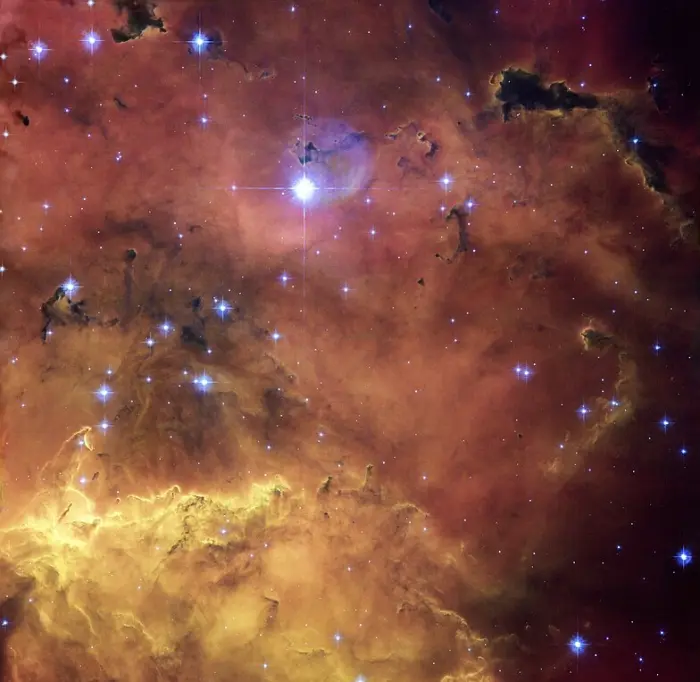
A colourful star-forming region is featured in this stunning NASA/ESA Hubble Space Telescope image of NGC 2467. Looking like a roiling cauldron of some exotic cosmic brew, huge clouds of gas and dust are sprinkled with bright blue hot young stars. Strangely shaped dust clouds, resembling spilled liquids, are silhouetted against a colourful background of glowing gas in this Hubble image. The star-forming region NGC 2467 is a vast cloud of gas – mostly hydrogen – that serves as an incubator for new stars. Some of these youthful stars have emerged from the dense clouds where they were born and now shine brightly, hot and blue in this picture, but many others remain hidden. The full beauty of this object and hints of the astrophysical processes at work within it are revealed in this super-sharp image from Hubble. Hot young stars that recently formed from the cloud are emitting fierce ultraviolet radiation that is causing the whole scene to glow while also sculpting the environment and gradually eroding the gas clouds. Studies have shown that most of the radiation comes from the single hot and brilliant massive star just above the centre of the image. Its fierce radiation has cleared the surrounding region and some of the next generation of stars are forming in the denser regions around the edge. Image credit: NASA, ESA and Orsola De Marco (Macquarie University) (CC BY 2.0)
Location
The Skull and Crossbones Nebula lies in the northern part of the constellation Puppis. It appears in the southern skies, in the same region as the bright open cluster Messier 93. The nebula can be found about a third of the way from Tureis (Rho Puppis) to Aludra (Eta Canis Majoris). Tureis, the third brightest star in Puppis, lies along the imaginary line extended from Saiph at Orion’s foot through Sirius in Canis Major. Aludra is part of a distinctive triangle located just below Sirius. NGC 2467 appears just south-southwest of Azmidi (Xi Puppis).
The Skull and Crossbones Nebula is a popular target for amateur astronomers and astrophotographers. It is visible in small telescopes.
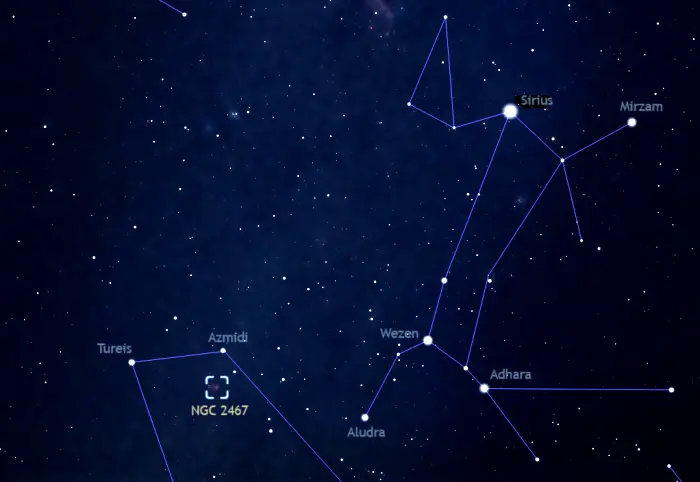
The location of the Skull and Crossbones Nebula (NGC 2467), image: Stellarium
At declination 26° S, the nebula is visible from locations north of the latitude 63° N. It does not rise very high above the horizon for observers in the mid-northern latitudes.
The best time of the year to observe NGC 2467 and other deep sky objects in Puppis is during the month of February, when the constellation appears higher above the horizon in the early evening.
Skull and Crossbones Nebula – NGC 2467
| Constellation | Puppis |
| Object type | H II region, open cluster |
| Right ascension | 07h 52m 18.5s |
| Declination | −26° 25′ 41″ |
| Apparent magnitude | 7.1 |
| Distance | ~20,000 light-years |
| Radius | 200 light-years |
| Names and designations | Skull and Crossbones Nebula, NGC 2467, Collinder 164 (Cr 164), Gum 9, Sh2-311, ESO 493-25, LBN 1065, LBN 243.28+00.51, LBN 1067, Minkowski 2-64 (Min 2-64), MWSC 1367, OCISM 128, OCl 668.0, RCW 16 |
Images
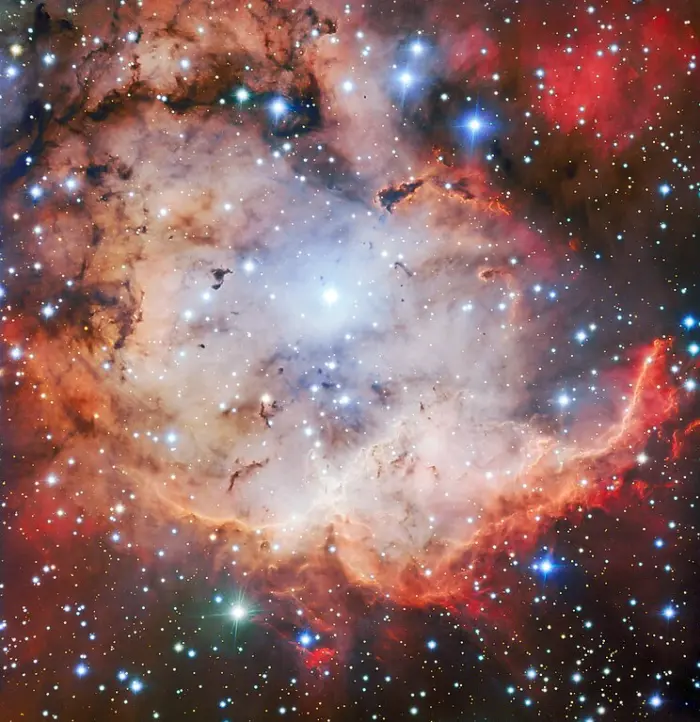
This vivid picture of an active star forming region — NGC 2467, otherwise known as the Skull and Crossbones nebula — is as sinister as it is beautiful. This image of dust, gas and bright young stars, gravitationally bound into the form of a grinning skull, was captured with the FORS instrument on ESO’s Very Large Telescope (VLT). Whilst ESO’s telescopes are usually used for the collection of science data, their immense resolving power makes them ideal for capturing images such as this — which are beautiful for their own sake. Image credit: ESO (CC BY 4.0)
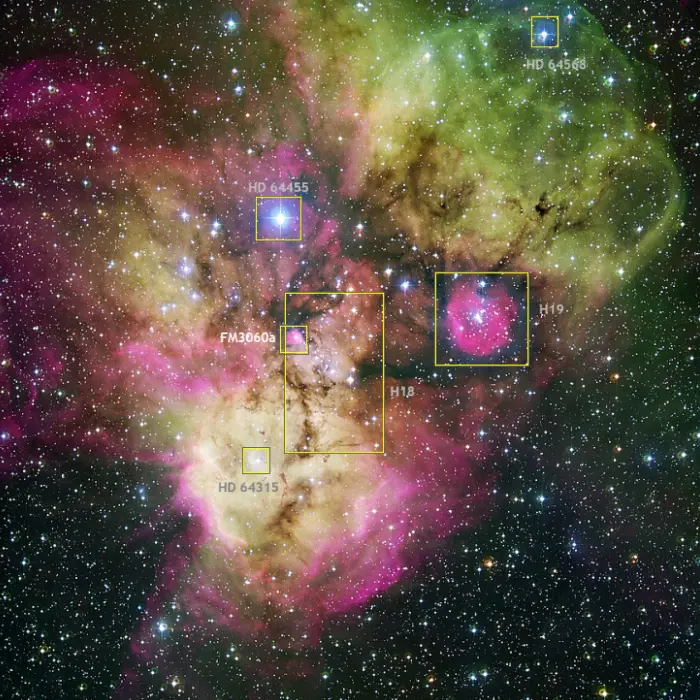
Area surrounding the stellar cluster NGC 2467, located in the southern constellation of Puppis (“The Stern”). With an age of a few million years at most, it is a very active stellar nursery, where new stars are born continuously from large clouds of dust and gas. The image, looking like a colourful cosmic ghost or a gigantic celestial mandrill, contains the open clusters Haffner 18 and Haffner 19, as well as vast areas of ionised gas. The bright star at the centre of the largest pink region on the bottom of the image is HD 64315, a massive young star that is helping shaping the structure of the whole nebular region. HD 64568 is a hot, exceptionally massive main sequence blue-white star that is the prototype of the O3 V((f*)) spectral category. In the center of this image, the open stellar cluster Haffner 18 illustrates three different stages of this process of star formation: In the centre of the annotated area, a group of mature stars that have already dispersed their birth nebulae represents the completed product or immediate past of the star-formation process. Towards the top left of the annotated area, a very young star, FM3060a, just comes into existence and still surrounded by its birth cocoon of gas, provides insight into the earliest moments of star birth. Finally, the dust clouds towards the bottom left corner of the annotated area are active stellar nurseries that will produce more new stars in the future. This image of NGC 2467 is based on 49 images in six different filters obtained in December 2003 with the Wide-Field Imager camera at the 2.2m MPG/ESO telescope, located at La Silla, in Chile. North is right and East is to the top. Bright red denotes the H-alpha line. Green denotes the green emission lines of doubly ionized oxygen OIII. Image credit: European Southern Observatory (CC BY 4.0)
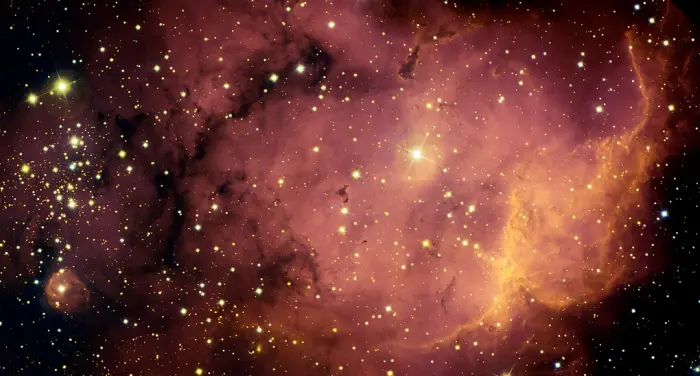
A very active stellar nursery glows in deep reddish tones in this Gemini view of NGC 2467 in the southern constellation of Puppis. The image displays a striking array of features that illustrate multiple phases of star birth. In the lower right, young stars are emitting hot radiation, exciting the nearby gas and causing it to glow and revealing denser gas and dust clouds. Dust lanes and dark globules mark sites of future star formation. A cluster of young stars dominates the left edge of the field of view. It is likely that several million years ago this region resembled the currently active star birth regions seen in the right half of the image. A “wall” of denser material dominates the right side of the image. Here ultraviolet radiation from nearby stars is removing material by a process called photo-evaporation and revealing underlying dense clouds that likely harbor forming stars. At bottom left a star can be seen exciting the cocoon of gas and dust from which it likely emerged. This image was obtained on December 5, 2004 using the Gemini Multi-Object Spectrograph (GMOS) on the Gemini South telescope at Cerro Pachón in Chile. Image credit: International Gemini Observatory/Travis Rector, University of Alaska Anchorage (CC BY 4.0)